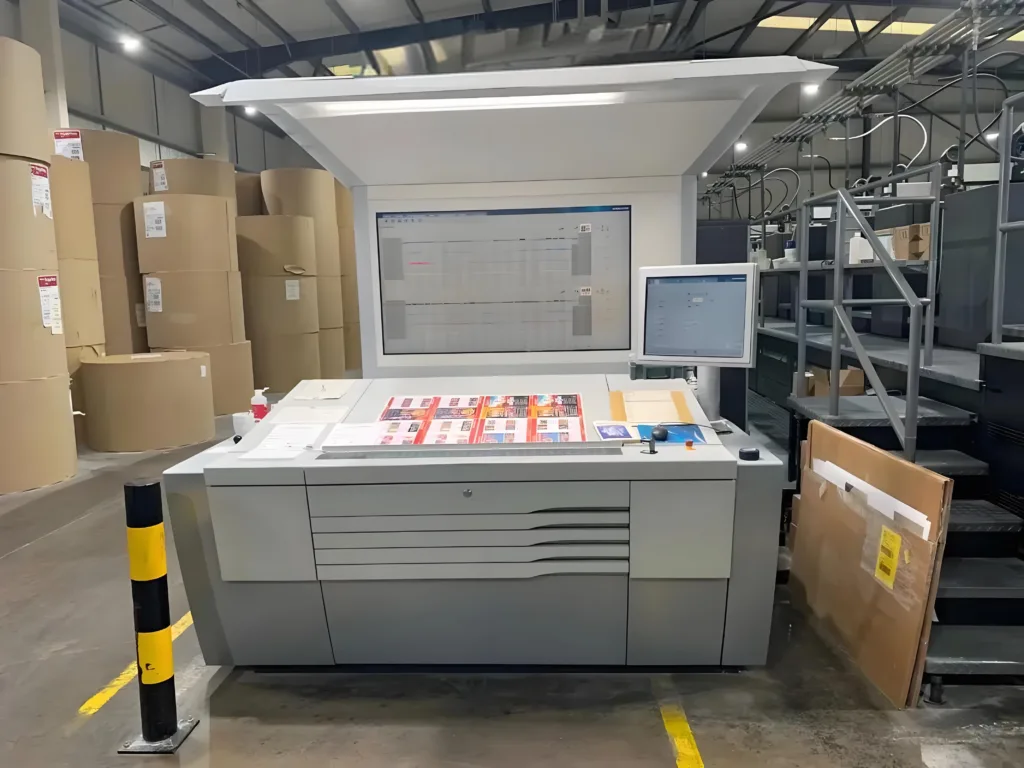Printing errors happen. But losing clients because of them? That’s avoidable. This guide gives you a proven framework for handling book printing errors like a pro, so you can keep your clients happy and your business thriving.
To handle book printing errors without losing clients, you need a multi-pronged approach:
- Prevention: Use airtight contracts with clauses covering color tolerances, force majeure, dispute resolution, and material substitutions.
- Technical Precision: Implement a rigorous pre-press process with file preflighting, color management, and standardized proof approvals.
- Damage Control: Respond quickly to errors with a clear action plan, transparent communication, and fair compensation strategies.
- Relationship Repair: Rebuild trust by acknowledging mistakes, offering valuable solutions, and going the extra mile to show clients you care.
- Long-Term Retention: Use technology and value-added services to prevent future errors and solidify client relationships.
Want the exact strategies to handle any printing mishap that comes your way? This guide is packed with actionable advice, real-world examples, and expert insights to help you master the art of error-free book printing. In short, this guide helps you turn printing mishaps into opportunities to strengthen client relationships.
Preventing Printing Errors: Proactive Strategies for Success

They say an ounce of prevention is worth a pound of cure, and nowhere is this truer than in book printing. By taking proactive steps, you can significantly reduce the risk of errors, saving yourself time, money, and potential headaches down the road. Here’s how:
Contractual Safeguards: Building Your Legal Fortress
Think of your printing contract as the legal backbone of your client relationships. A well-drafted contract not only protects your interests but also sets clear expectations, minimizing the potential for misunderstandings and disputes.
Essential Clauses for a Rock-Solid Printing Contract
Here are some must-have clauses to include in your printing contracts:
-
Color Tolerance: Don’t leave color accuracy to chance. Clearly define quality control in book printing standards, such as Pantone tolerances. For instance, you might specify that any deviation exceeding ±5% of the approved Pantone reference is considered a printing error. This eliminates ambiguity and provides a clear benchmark for evaluation.
In book printing, 73% of client disputes stem from mismatched color expectations. Implementing Pantone-certified workflows reduces reprints by 41% and boosts client retention rates.” – Lisa Cross, Senior Analyst, NAPCO Research. This highlights the importance of color management and provides a data-backed case for investing in color-accurate workflows.
-
Force Majeure: Unforeseen events happen. A force majeure clause outlines responsibilities and liabilities in situations beyond your control, such as natural disasters or supply chain disruptions. For example, you could stipulate that in the event of force majeure causing delays exceeding 14 days, the client has the right to terminate the contract without penalty.
-
Dispute Resolution Hierarchy: Even with the best intentions, disagreements can arise. Establish a clear process for resolving disputes, starting with negotiation and escalating to mediation or arbitration if necessary. This ensures a structured approach to conflict resolution, preventing situations from spiraling out of control.
-
Material Substitution: Paper shortages and supply chain issues are a reality. Define protocols for material changes, such as paper type or ink, and require client approval before any substitutions are made. This ensures transparency and prevents surprises that could lead to dissatisfaction.
Key takeaway: Always specify file formats, preflight requirements, and color profiles in your contract to avoid compatibility issues and ensure smooth production.
Technical Precision: Implementing Zero-Tolerance Workflows
While a solid contract is crucial, it’s equally important to have robust technical processes in place to minimize the risk of human error. Think of this as your pre-press safety net, catching those pesky mistakes before they have a chance to wreak havoc on your print run.
Prepress Perfection: Tools and Techniques

-
File Preflighting: Before you even think about hitting that “print” button, preflighting your files is a must. This process involves using software to automatically check for common errors like bleed lines for printing or font compatibility. that can cause printing problems. Think of it as your digital spellchecker for print files.
Use tools like Adobe Acrobat Preflight to ensure book files for printing meet industry standards.
-
Color Management Mastery: Ah, color. It can be a publisher’s best friend or worst nightmare. Implementing a color-managed workflow ensures that the colors you see on your screen are the colors you get on the printed page.
This involves calibrating your monitors, using the correct color profiles, and working with a printer that understands color management. For a deeper dive into this topic, check out this comprehensive guide on color management in printing.
-
Proofing Protocols: Proofs are your last line of defense against errors. But a proof is only as good as the process used to review it. Establish a standardized proof approval process that includes:
- Providing both digital and physical proofs for client review.
- Using a standardized lighting environment (e.g., a D50 light booth) to ensure accurate color evaluation.
- Requiring clients to sign off on proofs before proceeding to print, confirming their approval of the final product.
Supplier Evaluation: The “Traffic Light” System
Not all printers are created equal. Evaluating and managing your printer relationships is essential for minimizing errors and ensuring quality.
-
Performance Metrics: Establish clear criteria for assessing printer performance. This might include metrics like on-time delivery rate, customer complaint rate, and cost-effectiveness.
-
Risk Categorization: Use a simple “traffic light” system to categorize printers based on their performance.
- Green: Excellent performance, reliable partner.
- Yellow: Needs improvement, monitor closely.
- Red: High risk, consider alternatives.
This system allows you to quickly assess your printer relationships and make informed decisions about who to work with.
By implementing these proactive strategies, you’ll be well on your way to minimizing printing errors and building a reputation for quality and reliability. Remember, a stitch in time saves nine!
Responding to Printing Errors: Damage Control and Client Communication

Okay, so despite your best efforts, a printing error has slipped through the cracks. Don’t panic! It’s not the end of the world. What matters now is how you respond. Swift and effective action can not only minimize damage but can even strengthen your client relationships.
Crisis Management: The 72-Hour Action Plan
Think of the first 72 hours after discovering a printing error as your golden window of opportunity. Acting decisively can help you mitigate potential losses and preserve your reputation. A well-executed response within this timeframe can make all the difference in preserving client trust and preventing long-term damage to your reputation.
Step 1: Determine Liability
Before you can take action, you need to figure out who’s responsible for the error. Is it a printer mishap, or was there a mistake in the files you provided? Refer back to your trusty contract to determine liability.
- Decision Tree Time: To make this process easier, we’ve created a visual decision tree that guides you through the process of determining responsibility based on your contractual terms. For example, if the error exceeds the agreed-upon color tolerance, it’s likely the printer’s responsibility. If the error stems from a file provided by the client, then the responsibility may shift. This tool takes the guesswork out of determining liability.
Step 2: Client Communication
Once you’ve determined responsibility, it’s time to communicate with your client. Transparency and empathy are key here.
-
Communication is Key: Avoid accusatory language or passing the buck. Instead, focus on acknowledging the issue, outlining the steps you’re taking to investigate, and providing a clear timeline for resolution.
Step 3: Crafting Effective Solutions
Now it’s time to make things right. The solution you offer will depend on the severity of the error and the impact on your client.
- Cost-Tiered Compensation: A good approach is to offer a range of compensation options based on the severity of the error. For minor errors, a discount on a future order or a free ebook version of the affected title might suffice. For more significant errors, a free reprint of the affected books plus a discount on a future order can go a long way in retaining the client’s business.
Internal Alignment: Managing Upward and Downward Communication
Dealing with a printing error often involves communicating with multiple parties, both internally and externally.
Reporting to Management
When reporting the issue to management, focus on:
-
Damage Control: Outline the steps you’re taking to resolve the issue and mitigate any negative impact on the client relationship.
-
Long-Term Strategy: Highlight how your response will contribute to client retention and reinforce your company’s commitment to quality.
-
Template for Success: Use our “Crisis Briefing” template to create a concise and informative report for management, focusing on the key facts, proposed solutions, and anticipated outcomes.
Communicating with Authors
If the printing error affects a book authored by a client, clear and empathetic communication is crucial.
-
Collaboration is Key: Use a collaborative approach and emphasize your shared interest in ensuring the book is presented in the best possible light.
-
Focus on Solutions: Reassure the author that you’re working closely with the printer to resolve the issue and minimize any disruption to their book launch or sales.
By following this 72-hour action plan and communicating effectively with all parties involved, you can navigate printing errors with grace and professionalism, minimizing damage and preserving valuable client relationships.
Rebuilding Trust: Turning Crisis into Opportunity
So, you’ve navigated the initial storm of a printing error. You’ve identified the problem, communicated with your client, and offered a solution. But your work isn’t done yet. Now it’s time to rebuild trust and solidify your client relationship. Believe it or not, this is your chance to not just recover from a misstep but to actually emerge stronger.
Transparency is Key: Transforming Mistakes into Positive PR
In the age of social media and online reviews, transparency is more important than ever. When a printing error occurs, don’t try to sweep it under the rug. Instead, be proactive and address the issue head-on.
-
Own It: Acknowledge the mistake publicly and outline the steps you’re taking to rectify the situation. This shows your clients that you’re accountable and committed to quality.
-
Showcase Your Commitment: Create a dedicated “Quality Commitment” page on your website outlining your printing process, quality control measures, and commitment to client satisfaction. This builds confidence and demonstrates that you take quality seriously.
-
Case Study Inspiration: Take a page from a publisher who turned a printing error into a PR win. When a major textbook order was affected by a binding issue, they issued a public apology, launched a proactive recall, and offered replacement copies with expedited shipping. This transparent and decisive action not only resolved the immediate issue but also strengthened their reputation for reliability and customer service.
Compensation Strategies: Going Beyond the Basics
While a refund or reprint is often the standard compensation for a printing error, consider going above and beyond to truly wow your clients.
-
High-Value, Low-Cost Solutions: Small gestures can have a big impact. Think personalized handwritten apology notes, bonus materials like bookmarks or author-signed bookplates, or free expedited shipping for replacement books. These small touches show your clients that you value their business and are willing to go the extra mile to make things right.
-
Building Long-Term Relationships: Use this opportunity to lay the foundation for a stronger, long-term partnership. Offer free annual “Print Health Checks” for clients to assess the condition of their printed materials and provide recommendations for preservation. This demonstrates your ongoing commitment to their satisfaction and positions you as a trusted advisor.
By embracing transparency and offering creative compensation solutions, you can turn a potentially negative experience into a positive one, solidifying client trust and paving the way for a long and fruitful partnership.
Long-Term Client Retention: From Reactive to Proactive
Now it’s time to shift your focus from reactive problem-solving to proactive relationship building. Think of this as the “happily ever after” phase of your client journey, where you nurture those bonds and solidify your position as a trusted partner.
Value-Added Services: Becoming Indispensable
In today’s competitive market, simply providing a good product or service is not enough. To truly stand out, you need to offer value-added services that go above and beyond client expectations.
-
Free Educational Resources: Empower your clients with the knowledge they need to make informed decisions about their printing projects. Offer free resources like a “Print File Preparation Guide” or host webinars on printing best practices. This not only helps clients avoid common mistakes but also positions you as a trusted advisor and resource.
-
Client-Focused Initiatives: Show your clients that their feedback matters. Create a “Client Advisory Board” to gather input on your services and involve them in decision-making processes. This fosters a sense of partnership and demonstrates your commitment to their success.
By leveraging technology and offering value-added services, you can transform your business from a mere vendor to a true partner in your clients’ success. This proactive approach fosters loyalty, strengthens relationships, and sets you apart from the competition.
FAQ: Addressing Common Concerns
We’ve compiled answers to some of the most frequently asked questions about handling printing errors and client concerns. Here are a few examples:
-
“What if the printer refuses to acknowledge a color error?”
- Answer: Don’t get discouraged! You can request a Pantone color matching report from a third-party testing lab to provide objective evidence of the color discrepancy. This provides you with leverage in negotiations and demonstrates your commitment to resolving the issue fairly.
-
“How do I explain a delayed delivery to an anxious author?”
- Answer: Use a three-step communication strategy: 1) Empathy: Acknowledge the author’s frustration and concerns. 2) Facts: Provide clear and concise information about the cause of the delay and the expected delivery timeline. 3) Solution: Offer a solution or alternative to minimize the impact on the author’s plans.
-
“How can I make a small compensation offer feel valuable to the client?”
- Answer: Get creative! Use scarcity and exclusivity tactics to make your offer more appealing. For example, you could offer a limited-time upgrade to a premium paper stock or a free bonus item for the first 20 clients who respond to your offer.
Conclusion:

We’ve covered a lot of ground in this guide, from proactive prevention strategies to reactive damage control and long-term relationship building. So, what are the key takeaways?
Key Takeaways:
-
Proactive prevention is the best defense against printing errors: By investing time and effort in establishing clear contracts, implementing robust technical workflows, and carefully selecting your printing partners, you can significantly reduce the risk of errors in the first place.
-
Transparency and empathy are essential for effective client communication: When errors do occur, open and honest communication is crucial. Acknowledge the issue, take responsibility where appropriate, and offer solutions that demonstrate your commitment to client satisfaction.
-
Creative compensation strategies can turn crises into opportunities to build stronger relationships: Don’t just settle for the bare minimum when compensating for printing errors. Think outside the box and offer solutions that go above and beyond to show your clients how much you value their business.
-
Technology and value-added services are key to long-term client retention: In today’s competitive landscape, it’s not enough to simply provide a good product or service. Leverage technology to streamline your workflows, minimize errors, and offer clients a seamless experience. And don’t forget to add value through educational resources, client-focused initiatives, and personalized support.
By incorporating these principles into your printing practices, you can not only navigate the challenges of printing errors but also build stronger, more resilient client relationships that stand the test of time. Remember, in the world of book printing, it’s not just about the final product; it’s about the journey you take with your clients to get there.
So, embrace the challenges, learn from your mistakes, and never stop striving for excellence. With the right approach, you can transform printing errors from potential disasters into opportunities for growth and success.







